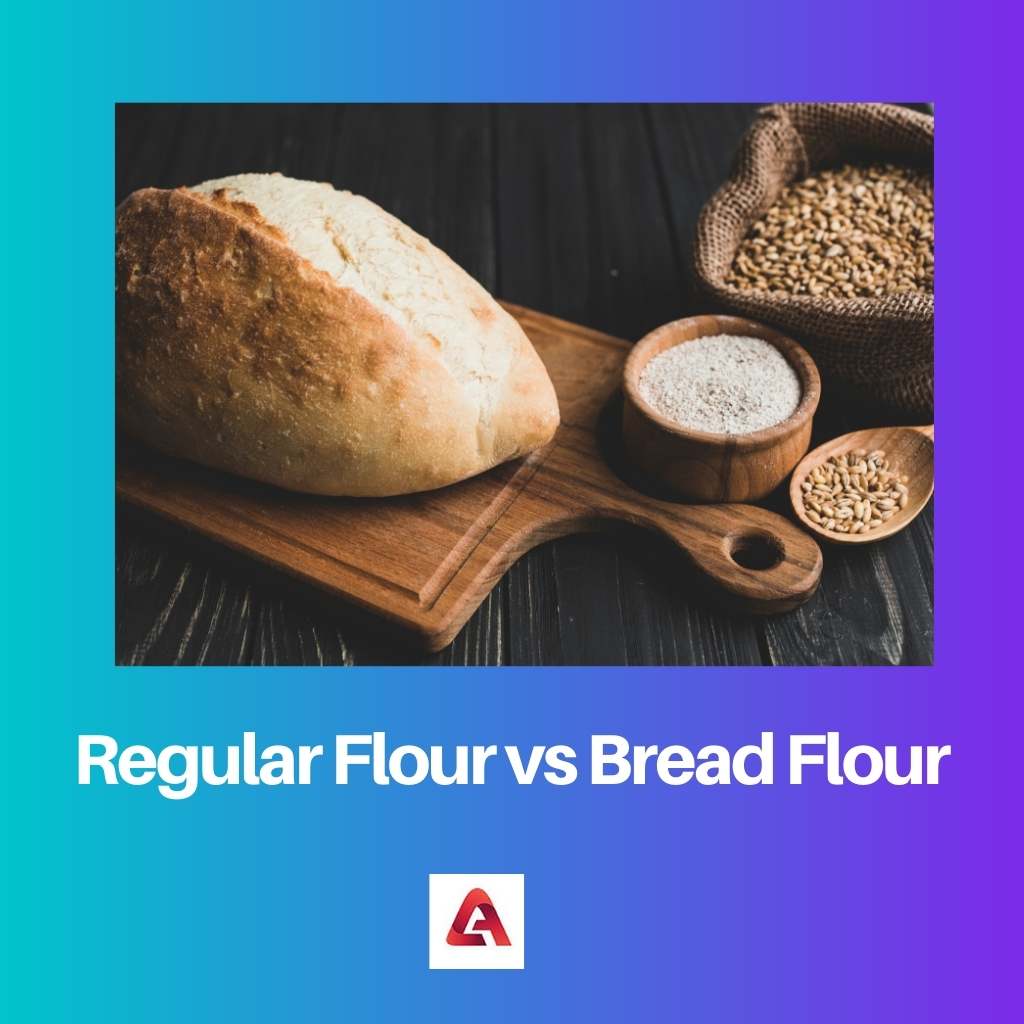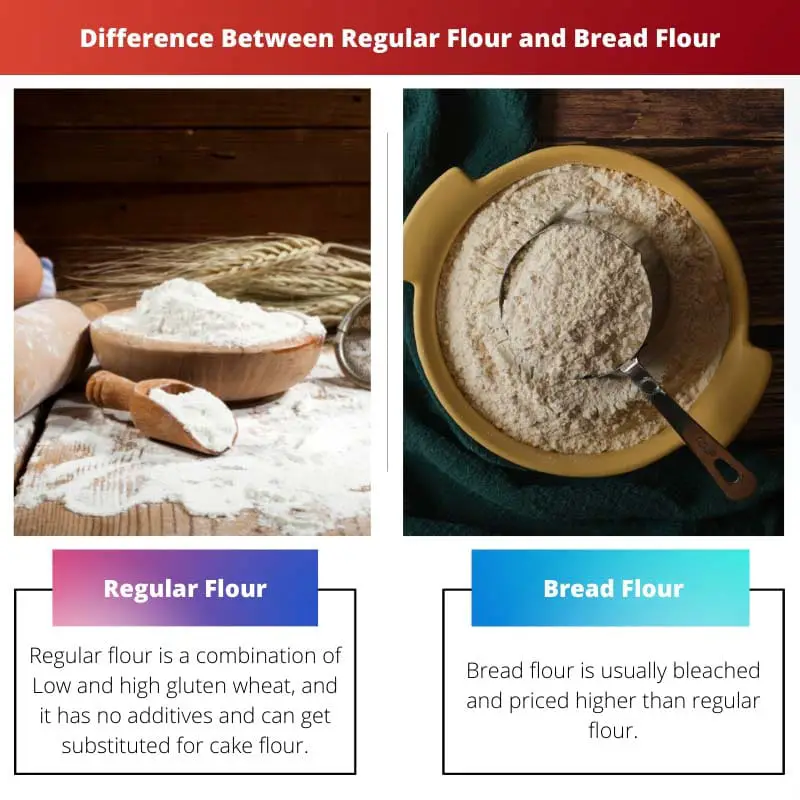Flour is a crucial ingredient in many recipes. From humble bread to delicious cakes, there are varieties of flour utilized. Flour may all look alike, but they differ in source and nutritional value.
According to the usage, flour is categorised as regular or bread flour.
Key Takeaways
- Bread flour has a higher protein content than regular flour, forming more gluten.
- Regular flour is versatile for baked goods, while bread flour is for yeast bread.
- Bread flour provides better elasticity and structure, while regular flour creates a softer, tender texture.
Regular Flour vs Bread Flour
Regular flour is a blend of soft and hard wheat flour. It has a moderate protein content of about 10-12%, which makes it versatile and suitable for a wide range of baked goods. Bread flour has a higher protein content of around 12-14%, which gives it a stronger gluten network when mixed with water.

Regular flour is a combination of Low and high-gluten wheat with no additives and can be substituted for cake flour. This flour is a crucial ingredient for cookies, biscuits, and cakes and is considered soft flour.
The flour is either bleached or unbleached and is widely available.
Bread flour is high in gluten and protein, contributing to the bread’s chewiness and toughness. Bread flour has traces of Vitamin C, Potassium Bromide, and barley flour. Bread flour is best for pizza base, bread, and yeast-risen goodies.
Bread flour is bleached and priced higher than regular flour.
Comparison Table
| Parameters of Comparison | Regular Flour | Bread Flour |
|---|---|---|
| Cost | It is less expensive | It is expensive. |
| Gluten | It has less protein and gluten. | It has high protein and gluten. |
| Additives | There are no additional additives. | Vitamin C and Malt Barley are the additives. |
| Produce | Mix of summer and winter. | Hard winter wheat. |
| Texture | Bleached and unbleached. | Unbleached. |
What is Regular Flour?
While making cookies, regular flour or all-purpose flour get utilized. As the name suggests, it is for general purposes. Pizza dough rolls and, at times, bread gets made from regular flour.
The gluten content in the flour plays a crucial role in the price of the flour. Since regular flour has less gluten content, it gets pocket-friendly.
You can replace the bread flour with regular flour as a substitute, but the overall outcome will be disappointing. The gluten content of the flour is crucial for delicious goodies.
The protein content of the flour is around 9% to 11%. This property allows the flour to retain its structure and provide the texture of the cakes, cookies, muffins, or bread.
You can opt for the all-purpose flour, or the organic version flour gets versatile with utility.
Since it has less protein, the gluten content is low. There is no added additive or extra ingredient. Regular flour can be classified as bleached or unbleached and has a long shelf life. It needs to get stored in airtight containers in a dry cabinet.
The shelf life is around eight months and up to a year if placed in the refrigerator. Regular flour or all-purpose flour is commonly available in any store due to the utility of the flour.

What is bread flour?
Bread flour is a good option for making bread and pastries. It contains around 12% to 14% protein and high gluten content, and this property helps the bread rise and get shape.
The bread flour made from hard wheat flour is a combination of soft and hard wheat flour, and it is mainly unbleached.
The property of gluten is the binding factor of the bread. When water gets added to the flour, the amino acids protein strands get created while mixing. It is the main reason to use bread flour for soft and yeast-baking bread.
The gluten captures the gasses during the process of leavening and cooking. Baking biscuits and pie crust in bread flour make it tough and chewy.
The high protein and gluten content make the bread chewy and tough. In addition, the bread flour’s yeast adds to the bread’s elasticity. The flour helps the bread retain its defined shape and be fuller.
The bread flour formed from hard wheat contains evidence of Vitamin C. It even has Barley flour and Potassium Bromide. It helps the yeast improve the bread texture and quickens the bread-making process.
It is the best option for pizza crust and other yeast products.
The bread flour must be stored in an airtight container, in cabinets or in the refrigerator. In the cupboard, it could last for several months and about a year in the fridge.

Main Differences Between Regular Flour and Bread Flour
- The regular flour could be bleached or unbleached. The bread flour is always unbleached.
- Regular flour is favoured and effortlessly available in the market. The bread flour is expensive and available in selective places.
- Regular flour is a combination of summer and winter wheat. The dense winter wheat is the crucial ingredient of bread flour.
- Regular flour has lower protein and gluten and could be considered soft flour. Bread flour has higher protein and gluten content and could be firm flour.
- Regular flour has no additives, hence being easily substituted. The bread flour has additives and cannot get replaced.

- https://ifst.onlinelibrary.wiley.com/doi/abs/10.1111/j.1365-2621.2006.01410.x
- https://www.sciencedirect.com/science/article/pii/S030881461301460X

Wow! I am so impressed by the amount of information and detail provided in this article. I’ve always wanted to know the difference between regular and bread flour, and this provided the information so thoroughly and clearly.
I’m glad I stumbled upon this article! Very informative. However, I think the comparison table could be summarized in a clearer format.
I agree with you. The article is detailed, but it could benefit from a better structure for the comparison table.
I found the explanation on the properties of gluten and protein content in regular and bread flours very insightful. I appreciate the scientific references provided.
While the detailed information is appreciated, I found the article a bit too long. It could have been more concise without losing any important points.
I respect your viewpoint, but I believe the length of the article allows for a thorough examination of the topic.
The tangible benefits of using regular flour in different baked goods and the advantages of bread flour for specific purposes are well-explained. I’m looking forward to applying this knowledge in my future baking activities.
This article has provided a comprehensive understanding of regular and bread flours. The details about protein and gluten content are particularly fascinating.
The scientific details really elevate this article and bring a deeper understanding to the topic.